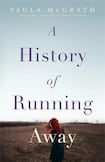
While Paula McGrath's debut novel may not have garnered quite as much attention as the work of some of her contemporaries, it was not for want of quality, for Generation, published in 2015, was a hugely impressive and compelling narrative that told the story of a woman escaping Ireland for a dramatic summer in Chicago.
As might be suggested by the title of this novel, the theme of escape reappears in her follow-up, as McGrath once again places women in situations of isolation, away from friends and family, reliant on no one but themselves, and considers how they confront and conform to unfamiliar and often dangerous landscapes.
Using a technique beloved by writers – three apparently unconnected stories that intertwine until we eventually discover the connections between them – the novel begins with a middle-aged woman prevaricating about a move to London to run a maternity hospital in 2012 before switching to an orphaned girl in Maryland during the same year, and then a runaway who escapes Ireland in 1982 for an unhappy London sojourn before returning to Dublin to discover an unexpected passion: boxing.
It is the last of these characters who dominates the novel. Jasmine’s arrival in England in the wake of a falling-out with her mother leads her to an unsavoury squat and the company of some small-time gangsters who take advantage of her youth and naivety to set her on a course to self-destruction. Escaping from their clutches through a means that will have every male reader crossing his legs and wincing in horror, she comes back to Dublin where a very different life opens up for her.
Watchful eye
It’s here that the novel takes life. Jasmine is a wonderful character, the beating heart of the story. For one thing, she’s smart. Smart enough to know that she wants more from the world than it’s currently offering her. When she discovers a local gym she begins a training course under the watchful eye of George, a Kenyan medical student, back at a time when there were very few black people in Dublin. George takes her running every morning, suffering no excuses, and gradually trains her to defend herself in the ring.
The relationship, however, offers strengths and weaknesses to the novel: the strength is the avoidance of cliche as there is not a hint of romance between the pair and George never treats Jasmine any differently than he would treat a male boxer. The weakness is the dialogue, for he has a habit of speaking in such pearls of wisdom that one can almost hear the velvet tones of Morgan Freeman narrating the audiobook. The fact that this kind of mentoring relationship is familiar from Million Dollar Baby doesn't help.
However, McGrath captures Dublin of the 1980s perfectly. The capital seems grubby, poised between the traditional landscape of drugs, smoke-filled bars and underground music venues and the dawn of a new society that was to come with the election of Mary Robinson in 1990. McGrath writes of the city in such a way that it seems both nostalgically familiar and horribly squalid simultaneously. She has a gift for allowing the streets to become characters unto themselves.
When Jasmine forms a friendship with Deano, another lonely soul living in her building, their relationship, mostly platonic, briefly romantic, is rather moving, mostly because Jasmine is nervous of letting anyone into her life and Deano, respecting and understanding this, behaves like a perfect gentleman and, more importantly, a friend.
Crescendo of emotion
If the novel has a flaw, it relates to the two sections that surround Jasmine’s story. The first, the older woman struggling with her conscience as she considers the move from Dublin, is interesting as she juggles the idea of leaving her dementia-riddled mother behind for a great job and a new relationship. It is a shame that McGrath does not devote more time to the development of this idea.
The second, the orphaned girl running away in search of her birth family, is also a little underwritten and it’s hard not to feel that the author has a favourite child, so to speak, among her narratives as she devotes more time and energy to it than to her other children. But I found myself interested in all of them, and felt a slight sense of disappointment that I was not offered more.
But this does not overshadow the novel itself, which is ambitious, both structurally and narratively, and elegantly written. McGrath’s insights into the mind of Jasmine as she delves deeper into the world of the then-illegal realm of women’s boxing are shrewd, and the novel reaches a crescendo of emotion when the various strands connect, in an authentic, credible and ultimately poignant fashion.
On the strength of her first two novels, I think it’s fair to say that Paula McGrath is one of our better young writers. I suspect there will be greater gifts from her imagination to come in the years ahead.
John Boyne's latest novel is The Heart's Invisible Furies (Doubleday)













